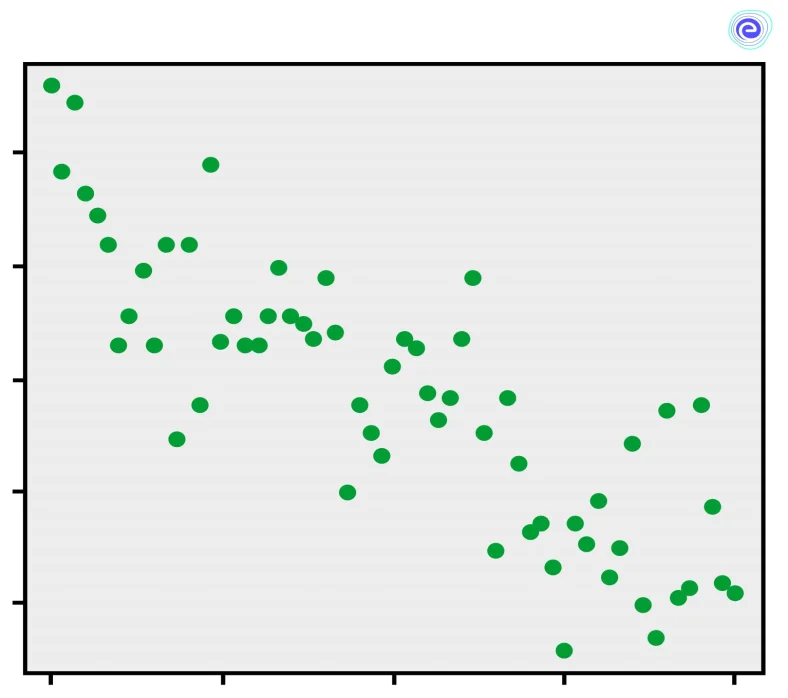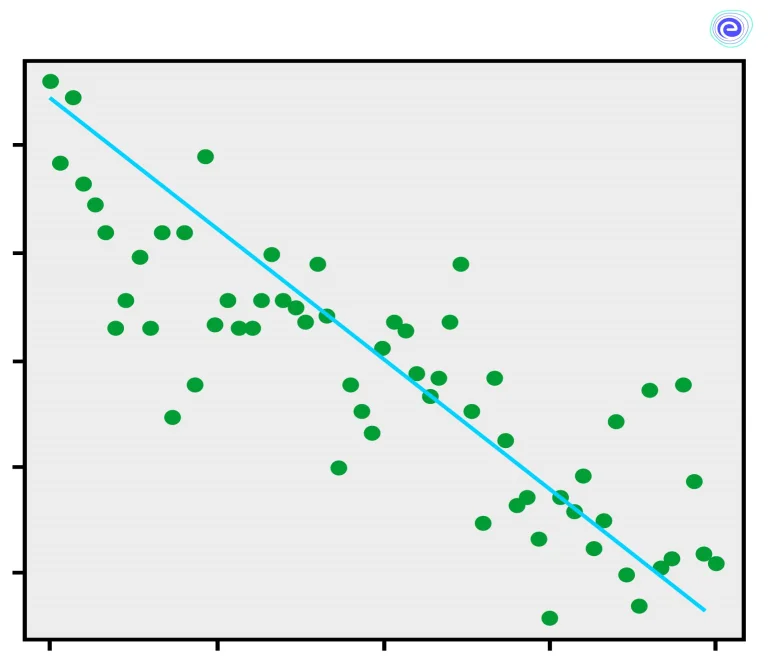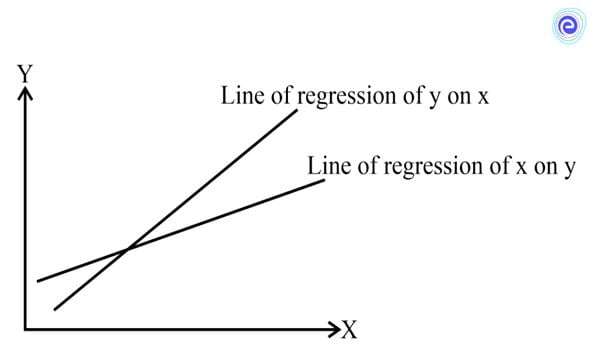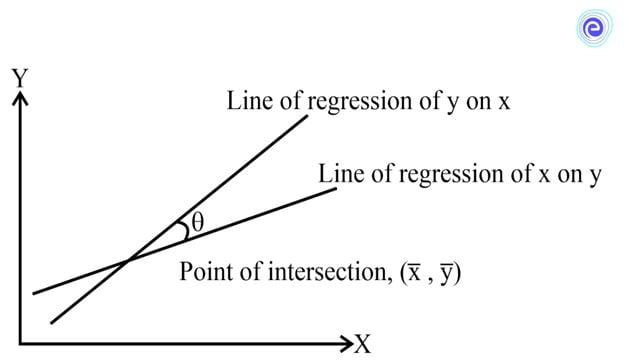- Written By
Simran Simran
- Last Modified 18-12-2024
Angle Between Two Lines of Regression: Forecasting or prediction is a crucial part of human life. We always try to stay ahead of things that we do, we plan for the future, and for doing this, we always look back at how things took place. They say, “History repeats itself.” Although vague, this is the simplified version of the concept of mathematical regression.
Regression means going back or taking a step back. Regression analysis is a mathematical way of establishing an average relationship between the independent and dependent variables. We can then use this relationship to predict future results or study past data. In this article, let us learn about lines of regression and the angle between them.
Curve of Regression
A scatter diagram is a graph of dots plotted with the values of the dependent and independent variables. If the two variables are related, the points on the scatter diagram will look more or less concentrated around a curve called the curve of regression.
What are Lines of Regression?
If this curve is a straight line, it is a case of linear regression, and the straight line is called the line of regression. Regression lines are the lines of best fit, so they try to cover as many points from the scatter diagram as possible. These lines express the average relationship between variables. In linear regression, we find the lines of regression by the concept curve fitting using the principle of least squares.
Why are there Two Lines of Regression?
The method of least squares minimises the sum of the squares of the errors from a specified value. Depending upon which variable we select as the dependent variable from and , there can be two lines of regression.
Line of Regression of on
We use this line to find the value of the dependent variable for a given value of the independent variable . We use the least squares method to minimise the squares of the errors of the available values of from the mean value of i.e.
Line of Regression of on
We use this line to find the value of the dependent variable for a given value of the independent variable . We use the method of least squares to minimise the squares of the errors of the available values of from the mean value of i.e.
The line of regression of on is given by the equation .
The line of regression of on is given by the equation .
Here,
Mean of the values of
Mean of the values of
Standard deviation of the values of from
Standard deviation of the values of from
Correlation coefficient
According to these formulas, we can see that both these lines pass through the point . Thus, this is the point of intersection of these two lines.
Angle Between the Two Lines of Regression
We have seen that the two lines of regression intersect at the point . Therefore, for a correlation that is not perfect, the two lines will be at an angle to each other.
The line of regression of on is given by the equation
Let the slope of this line be .
We can rewrite the line equation as
When we compare this with the standard line equation, , we get
Similarly, the line of regression of on is given by the equation
Here, let the slope of this line be .
When we compare this with the standard line equation, , we get
For two intersecting lines with slopes and , the angle between these two lines, , can be found by the formula,
PRACTICE EXAM QUESTIONS AT EMBIBE
Type of Correlation and Angle of Regression
Following are the different types of Correlation and Angle of Regression
1. If we substitute in the equation of we get,
(not defined)
It means that when , the angle between the lines of regression is .
means the variables and have no correlation.
Thus, for uncorrelated variables and , the lines of regression are perpendicular to each other.
2. If we substitute in the equation of we get,
or
It means that when , the angle between the lines of regression is or .
means the variables have a perfect positive or perfect negative correlation.
Thus, for perfectly correlated (positive or negative) variables and , the lines of regression are coincident.
3. The modulus in the formula of indicates that it can take two values.
For a single value of ,
- will give the acute angle between the two lines of regression, i.e., .
- will give the obtuse angle between the two lines of regression, i.e., .
4. As the angle between the two lines of regression decreases from to , the correlation between the variables increases from to .
5. As the angle between the two lines of regression increases from to , the correlation between the variables increases from to .
Solved Examples – Angle Between Two Lines of Regression
Below are a few solved examples that can help in getting a better idea.
Q.1. For two variables, and , the correlation coefficient is . The acute angle between the two lines of regression is . Show that .
Ans: Correlation coefficient,
Angle between the two lines of regression,
Substituting these values in the equation of ,
Since, the angle given is acute, we can write
or
Q.2. For two variables, and , regression coefficients are and . If is the angle between the two regression lines, then find the value of .
Ans: We know that,
Now,
This is one more formula for the angle between two lines of regression.
Q.3. If the standard deviation of is twice the standard deviation of , find the tangent of the acute angle between the two lines of regression if the correlation coefficient is .
Ans: Standard deviation of
Correlation coefficient,
We know that for the acute angle between the two lines of regression,
Q.4. The regression lines of on and on are and , respectively. Find the angle between these lines.
Ans: Line of regression of on
Line of regression of on
Angle between the two lines of regression,
This is the acute angle between the two lines of regression.
Q.5. The two lines of regression are and . Calculate the angle between the two lines of regression.
Ans: We do not know which of these lines is the line of regression of on and the line of regression of on .
Assume that the line of regression of on is , and the line of regression of on is .
We now represent these equations in proper form.
Line of regression of on
Line of regression of on
According to this assumption, and
We know that,
This assumption gives a value of , which is not possible. It means our assumption is incorrect.
Thus,
– Line of regression of on and – Line of regression of on
Line of regression of on
Line of regression of on
Angle between the two lines of regression,
Summary
There are two lines of regression, each trying to minimise the deviations of and from their means by the method of least squares. The two lines of regression intersect at the point whose coordinates give the means of both the variables, i.e. . The formula for the angle between the two lines of regression is . When the angle between the two lines of regression is or then there is a perfect correlation between the two variables. When the angle between the two lines of regression is then there is no correlation between the two variables. Thus, the angle between the two lines of regression is a connecting link between regression and correlation.
FAQs on Angle Between Two Lines of Regression
Students might be having many questions with respect to the Angle Between Two Lines of Regression. Here are a few commonly asked questions and answers.
Q.1. How do you find the angle between two regression lines?
Ans: You can find the angle between the two lines of regression by using the formula
Here,
Standard deviation of the values of from
Standard deviation of the values of from
Correlation coefficient
Q.2. What are the two lines of regression?
Ans: The two lines of regressions are a line of regression of on and a line of regression of on .
- Line of regression of on – It establishes a relationship between and . It is used to find the unknown value of the dependent variable for a known value of the independent variable .
- Line of regression of on – It establishes a relationship between and . It is used to find the unknown value of the dependent variable for a known value of the independent variable .
Q.3. Under what condition will the angle between two regression lines become zero?
Ans: The angle between the two regression lines becomes zero when the two variables are in perfect correlation, either positive or negative.
Q.4. When the correlation coefficient increases from to , how does the angle between the regression lines diminish?
Ans: When the correlation coefficient increases from to , the angle between the regression lines diminishes from to .
Q.5. Why there are two regression lines? Write the properties of regression lines.
Ans: There are two lines of regression each trying to minimise the squares of deviations of and from their means by the method of least squares.
Line of regression of on – It minimises the deviations of squares of values of from its mean parallel to the -axis.
Line of regression of on – It minimises the deviations of squares of values of from its mean parallel to the -axis.
ATTEMPT MOCK TESTS ON EMBIBE
We hope this information about the Angle Between Two Lines of Regression has been helpful. If you have any doubts, comment in the section below, and we will get back to you soon.













































